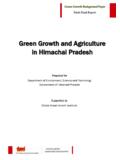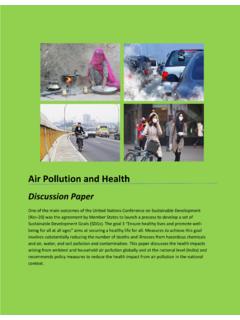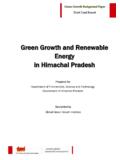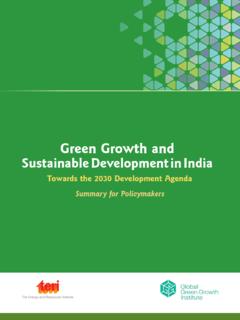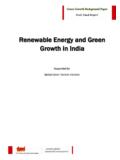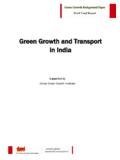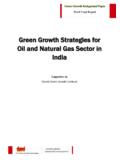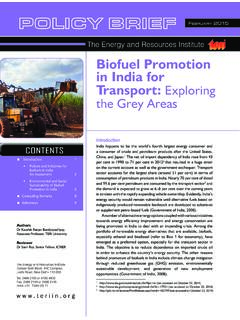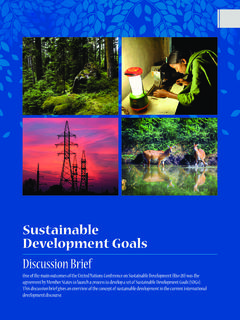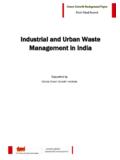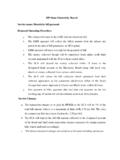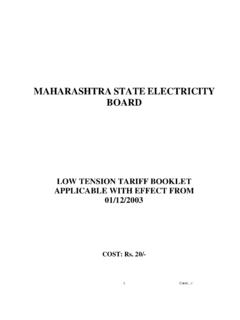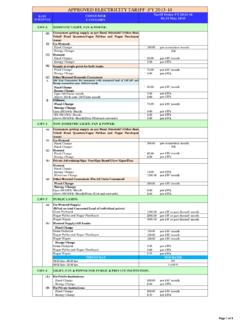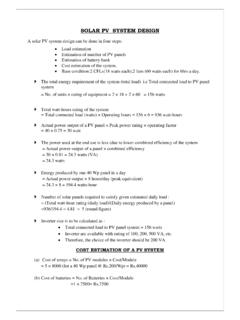Transcription of Green Growth and Climate Change Mitigation in …
1 Prepared for Department of Environment, Science and Technology Government of Himachal Pradesh Supported by Global Green Growth Institute Green Growth and Climate Change Mitigation in Himachal Pradesh Draft Final Report Green Growth and Climate Change Mitigation in Himachal Pradesh ii The Energy and Resources Institute 2015 Suggested format for citation T E R I. 2015. Green Growth and Climate Change Mitigation in Himachal Pradesh. New Delhi: The Energy and Resources Institute. 8 pp. Author Swati Agarwal, Research Associate, TERI Email: Reviewer Neha Pahuja, Fellow, TERI Email: For more information Project Monitoring Cell T E R I Tel. 2468 2100 or 2468 2111 Darbari Seth Block E-mail IHC Complex, Lodhi Road Fax 2468 2144 or 2468 2145 New Delhi 110 003 Web i i India India +91 Delhi (0)11 Green Growth and Climate Change Mitigation in Himachal Pradesh iiiTable of contents 1. Introduction _____ 1 2.
2 GHG Emission Trends in HP _____ 1 3. Institutional Framework _____ 2 4. Climate Change Mitigation Interventions _____ 3 Policy for Climate Change , 2008 _____ 3 Carbon neutral state policy, 2010 _____ 3 State Action Plan on Climate Change , 2012 _____ 3 5. Future GHG emission Trend in HP _____ 5 6. Barriers, challenges and opportunities _____ 6 Gaps in Understanding Climate Data _____ 6 Build Capacities _____ 6 Transfer of technologies _____ 6 Climate Finance _____ 6 7. Ways Forward _____ 6 8. References _____ 8 List of Tables Table 1 GHG emissions from different sources in Himachal Pradesh .. 2 Table 2 Removals Hydro Power Generation .. 2 Table 3 Future energy demand projections for the state .. 5 11. Introduction Himachal Pradesh (HP) is a northern state in India situated in western Himalayas, which covers an area of 55,673 Km, with population of 68, 56, 509 persons as per the Census of India 2011 (.)
3 57% of total population of India). The economy of the state is dependent on sectors like hydel power generation, horticulture, agriculture, forestry and tourism. The state is currently facing major challenges due to Climate Change particularly because: It is an agrarian economy with 90% rural population dependent on it for livelihood HP is dependent on rains for its economic activities Sustainability of hydro economy is dependent on snow and glaciers Climate induced and other natural disasters threat in the state. Based on modeling and other studies, it is evident that the Climate in the state is changing, and that there is rise in temperature in the NW Himalayan Region by about degree in the last century. Warming rate of the city of Shimla was higher during the period 1991-2002 as compared to earlier decades and reduction in rainfall by about 17% from 1996 onwards. It is alarming that there is a sharp reduction in the monsoonal discharge of rivers in the state which can potentially impact not only HP but all other states in the country in the downstream.
4 Erratic weather patterns have started to lead to shifting of farming practices in the state which can no longer sustain good harvest of some of the popular products produced in the state till 1990s. Within the realization that State vulnerabilities can be reduced through proactive measures in both Mitigation and adaptation, HP has taken measures to mitigate greenhouse gases (GHGs) through several initiatives discussed in the following sections. 2. GHG Emission Trends in HP Himachal Pradesh has established the inventory of GHG emissions for its sectors and sub-sectors for gases like CO2, CH4, N2O emitted as a result of anthropogenic activities at the state level from sectors like Energy, Industry, Agriculture, Waste, and Land Use Land Use Change & Forestry (LULUCF). The source of activity data taken for deriving calculations is primary from the published documents of different organizations in the state and the studies carried out by HP State Council for Science, Technology and Environment (HPSCST&E), HP State Pollution Control Board (HPSPCB), Departments of Transport, Economic and Statistics, HP State Electricity Board (HPSEB), and Forest and Agriculture.
5 The methodology, emission factors used in the calculations had been drawn from Indian Network on Climate Change Assessments (INCCA) country specific reference available in Intergovernmental Panel on Climate Change (IPCC) publications. After the national GHG Inventory was created in the year 2010 by INCCA, Himachal Pradesh formulated its own inventory of emissions in the state in May the same year, published in 2012. Summary of findings are given in table 1 below. Green Growth and Climate Change Mitigation in Himachal Pradesh 2 Table 1 GHG emissions from different sources in Himachal Pradesh Type GHG in CO2-eq (Gg) in 2009 GHG in CO2-eq (Gg) in 2012 Electricity/Energy 5122 1 Captive generation and consumption 244 2 Transport 716 3 Residential 1405 4 Industrial/Commercial 2757 5 Agriculture - Industry 5512 Agriculture 248 LULUCF (-) (-)1685 Waste .0061.
6 003 Total 9197 Source: Himachal Pradesh GHG Inventory Report, 2012; Himachal Pradesh GHG Inventory Report 2014 Note: emissions/removals due to hydro power generation in the state ( GW) as its contribution to clean energy is not taken into account in GHG estimation. Table 2 Removals Hydro Power Generation GHG emissions (Gg) Power generation (Hydro Power only) (-) Source GH G In ven tory Rep ort H im ach al Prad esh , 2014 Note: Estimated CO2 removals are equivalent to Kwh power to be replaced by hydro power contributed to the grid. Total emission in HP is MtCO2e which is of the total GHG emissions in the country in 2009 which has come down to MtCO2e in 2012 according to the latest Inventory report of the government released in 2014. Carbon sinks from LULUCF in the state of Himachal Pradesh has risen over the years. While GHG emissions have come down in the overall energy sector, particularly in the transportation sector it has witness a slight increase.
7 The contribution of other industry activities and agriculture sectors have also increased marginally, waste sector in the total emissions remain insignificant. The major source of GHGs emissions is bulk demand of energy from industry, commercial, tourism and development activities. Energy demand from residential sector is also showing need for Mitigation measures in the state. Awareness generation among the people is critical. Cement industry in the state is also a major source of GHGs emissions. Clear strategy to address Mitigation in this sector is needed. 3. Institutional Framew ork The State of Himachal Pradesh has constituted a State Level Governing Council on Climate Change , under the chairmanship of the Chief Minister. The Council has broad based Green Growth and Climate Change Mitigation in Himachal Pradesh 3representation from key stakeholders and representative line departments.
8 The Council provides guidance on matters relating to national level negotiations including bilateral, multilateral programmes for collaboration, research and development in the state, and is responsible for coordinating national action plans on State s agenda. An Executive Council under the chairmanship of Chief Secretary, Himachal Pradesh is also set up which is responsible for implementation and monitoring of the directives of State Governing Council on Climate Change . The Department of Environment, Science and Technology (DEST), Himachal Pradesh is the nodal agency which coordinates all activities related to Climate Change . Beyond this, government would ensure that the implementation of measures at sectoral level will be the responsibility of the relevant government departments and agencies. Recently, State Center on Climate Change has been set up under HPDEST to steer state s efforts to deal with Climate Change .
9 4. Climate Change Mitigation Interventions Policy for Climate Change , 2008 Himachal Pradesh was one of the few states to draft its own Policy for Climate Change in 2008, well before the federal directions on the State Action Plan on Climate Change was released in 2009. The policy focused primarily on roadmap for seeking the benefits of carbon credits through the Clean Development Mechanism for the State. HP is the first Indian State to sell carbon credits from community lands under the Clean Development Mechanism of UNFCCC. The bio-carbon project for expanding forestry plantations on mostly degraded land was expected to sequester nearly 800000 tonnes of CO2 from 2006 to 2025. The Mid- Himalayan Water Shed Development Project of the government is also expected to generate Certified Emission Reductions (CERs) around 41,979 annually. Carbon neutral state policy, 2010 In 2012, HP announced its ambition to become a carbon neutral state by 2020.
10 Towards this endeavor the state started a programme on Community led Assessment, Awareness, Advocacy and Action Programme (CLAP) for environment protection and carbon neutrality initiatives. This programme has been envisioned to assess the carbon and environment footprint at Panchayat level, the smallest unit of governance and through advocacy usher in sustainable development goals in partnership with the citizens. However, it is unclear as to how the government is planning to achieve this target. State Action Plan on Climate Change , 2012 The State Action Plan on Climate Change (SAPCC) was prepared and endorsed by the MoEF in state government constituted a State Level Governing Council on Climate Change (SGCCC), under the Chairmanship of Chief Minister which comprise of a broad based representation from key stakeholder departments to monitor the targets, objectives and achievements of the eight specific Missions.
